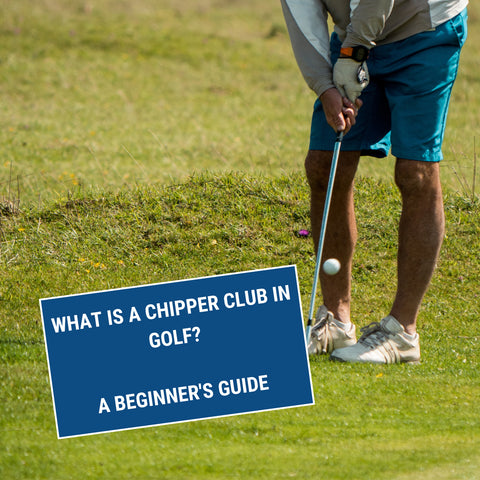Among the array of golf clubs available, the chipper stands out as a unique and versatile tool that can significantly impact your performance on the course. In this article, we'll take you on a journey to understand the chipper golf club inside out. From its definition and historical roots to its pivotal role in modern golf, we've got you covered.
So, whether you're a curious beginner wondering about this intriguing club or a seasoned golfer seeking to refine your short game, let's explore the fascinating world of golf chippers together. By the end of this article, you'll have a clear understanding of what makes a chipper club an indispensable addition to your golf bag.
Table of Contents
- Understanding the Chipper Golf Club
- Mastering the Chipper
- Who Should Consider Using a Golf Chipper?
- The Legal Aspect of Golf Chippers
- Top Golf Chippers to Try
- Are Golf Chippers Worth It?
- When and Where to Use a Chipper in Golf
- Exploring the Myths and Misconceptions
- Conclusion
- Frequently Asked Questions (FAQs) About Golf Chippers
Section 1: Understanding the Chipper Golf Club
Defining the Chipper Golf Club
| Aspect | Description | Importance |
|---|---|---|
| Loft | Typically ranges from 32 to 37 degrees | Determines trajectory |
| Length | Typically shorter than traditional irons | Affects control and accuracy |
| Clubhead Design | Combines elements of putters and irons | Influences ball contact |
| Grip | Standard golf grip or specialized design | Affects feel and control |
| Material | Stainless steel, steel, or other materials | Influences durability |
| Versatility | Suitable for a variety of short game shots | Enhances shot selection |
| Legal in Tournaments | Must conform to USGA rules for legality | Determines tournament use |
| Skill Level | Suitable for beginners to advanced players | Impacts ease of use |
A chipper golf club is a specialized club designed for short-range shots played around the green. Unlike traditional irons or woods, the chipper's design is unique, featuring a combination of characteristics borrowed from both putters and irons. It typically has a shorter shaft, a lofted clubface, and a design that allows for a putting-style stroke.
Tracing the History and Evolution
To truly appreciate the chipper, let's take a step back in time. The concept of a chipper club has been around for decades, but its evolution has been marked by innovation and adaptation to the ever-changing demands of golfers. Early versions resembled putters with lofted faces, while modern chippers incorporate advanced materials and design elements for enhanced performance.
The Modern Necessity
In today's golfing landscape, chippers have evolved from being a novelty to an essential tool in a golfer's arsenal. They excel at executing delicate, low-flying shots from close range, making them invaluable for achieving accurate and controlled approaches to the green. Whether you're navigating tricky hazards or aiming for a precise landing, the chipper's unique design offers a solution that can significantly lower your score.
Now that we've laid the groundwork for understanding golf chippers, let's delve deeper into how to wield this club effectively and explore its benefits for golfers of all levels.
Section 2: Mastering the Chipper
How to Hit a Chipper Golf Club Effectively
Mastering the art of using a chipper golf club effectively requires a combination of technique and practice. Here are some key pointers to help you become more proficient with this unique club:
Proper Stance and Grip
Achieving a consistent and effective chip shot starts with your stance and grip. When using a chipper, adopt a stance that is slightly open to your target. Your weight should favour your front foot, and your hands should be positioned slightly ahead of the clubhead. This setup promotes a descending strike, crucial for clean contact with the ball.
In terms of grip, a slightly firmer hold is recommended. This ensures that your wrists remain stable throughout the stroke, allowing for better control over the chipper's lofted face.
Swing Techniques
The key to a successful chip shot is a controlled and smooth swing. Unlike a full swing with a driver or iron, the chipper requires a shorter, pendulum-like motion. Keep your wrists quiet during the swing and focus on the movement of your shoulders and arms. The goal is to create a consistent, low-trajectory shot that rolls smoothly towards your target.
Let me share a personal anecdote from a seasoned golfer who discovered a game-changing chipper technique. "I was struggling with my chipping game for years until I learned a tip from a pro. They emphasized keeping my wrists quiet and treating the chipper like an extension of my putting stroke. It revolutionized my short game and reduced my scores."
The Difference Between Using a Chipper and a Wedge
It's essential to understand when to use a chipper versus a traditional wedge. While both clubs are designed for short shots around the green, they serve different purposes. Chippers are ideal for low, running shots that require minimal carry over obstacles. In contrast, wedges are better suited for high, soft shots that need to stop quickly.
By mastering the chipper, you'll have a valuable tool in your bag for situations where precision and control are paramount.
Section 3: Who Should Consider Using a Golf Chipper?
Identifying the Target Audience for Chipper Clubs
Chipper clubs cater to a diverse group of golfers, from beginners to seasoned pros. Identifying the target audience for chipper clubs involves understanding the specific advantages they offer:
-
Beginners: Novice golfers often struggle with their short game. Chippers provide a forgiving option for those learning to make accurate contact with the ball. They instil confidence and help beginners navigate challenging situations around the green.
-
Mid-handicappers: Golfers with moderate skill levels benefit from the versatility of chippers. They can save strokes by executing precise chip shots, particularly in situations where they need to avoid hazards or undulating greens.
-
Seniors: Chipper clubs are favoured by many senior golfers due to their ease of use. The club's design allows seniors to maintain control and distance without requiring excessive power.
The beauty of a chipper lies in its adaptability to various skill levels. For beginners, it serves as a reliable tool for gaining confidence and improving their short game. Intermediate golfers appreciate its precision, while seniors find it accommodating for their evolving needs on the course.
Section 4: The Legal Aspect of Golf Chippers
Are Golf Chippers Legal in Official Tournaments?
One of the most common questions golfers have about chipper clubs is whether they are legal in official tournaments. The short answer is yes, but there are some important considerations.
The United States Golf Association (USGA), the governing body for golf in the United States, sets the rules for golf equipment, including clubs. According to USGA rules, golf chippers are indeed legal for play in official tournaments. However, there are specific regulations governing the design and characteristics of golf clubs, including chippers.
Explanation of USGA Rules Regarding Equipment
The USGA's rules regarding golf club equipment are designed to maintain a level playing field and prevent equipment from providing an unfair advantage. When it comes to chippers, they must conform to the following USGA rules:
-
Club Length: The club must not exceed the maximum length allowed for a golf club, which is 48 inches.
-
Clubhead Design: The clubhead must conform to the rules regarding size, shape, and design set by the USGA.
-
Grip: The grip of the chipper must comply with grip rules, including size and material.
By adhering to these rules, chipper manufacturers ensure that their clubs are legal for tournament play.
Misconceptions About Golf Chippers
There is a common misconception that chipper clubs are not legal due to their unique design and combination of putter and iron-like features. It's essential to clarify this misconception and reassure golfers that, when manufactured in accordance with USGA guidelines, chippers are indeed permissible in official tournaments.
Section 5: Top Golf Chippers to Try
Popular and High-Quality Chipper Brands
Now that we've established the legality of golf chippers, let's explore some top-notch chipper brands that are worth considering. These brands have garnered acclaim for their quality and performance on the course:
-
TaylorMade: Renowned for innovation, TaylorMade offers chipper models designed to enhance precision and control around the green.
-
Odyssey: Odyssey's chipper options, such as the X-Act Tank Chipper, are known for their balance and consistency in chip shots.
-
Cleveland Golf: With the Smart Sole 4.0 Chipper, Cleveland Golf provides golfers with a reliable option for tackling various short game situations.
-
Callaway: The Mack Daddy PM Grind chipper from Callaway combines technology and design to help golfers master their short game.
Section 6: Are Golf Chippers Worth It?
Discuss the Cost vs. Benefits of Owning a Chipper
The question on many golfers' minds is whether investing in a golf chipper is worth it. Let's break down the cost versus the benefits to help you make an informed decision.
Cost Considerations:
- Golf chippers typically come with a price tag, albeit not as high as some other clubs. Our own range currently runs from £29.95-£44.95.
- Consider your budget and how a chipper fits into your overall golf equipment investment.
Benefits:
- Improved Short Game: Chippers excel at executing precise chip shots, which can significantly lower your scores.
- Confidence Boost: Many golfers find chippers easier to use, leading to increased confidence in their short game.
- Versatility: Chippers can be handy in various situations around the green, reducing the need for multiple clubs.
- Time-Saving: Using a chipper effectively can speed up play by minimizing the time spent around the green.
Real-World Examples Of Chipper Use
To illustrate the worth of a golf chipper, consider this real-world scenario: Imagine you're faced with a challenging shot from the fringe, just off the green. You can choose between using a chipper or a traditional wedge. With the chipper's design, you confidently execute a precise shot, and the ball rolls closer to the hole. This real-time improvement in your short game can be a game-changer, making the chipper's value evident.
Chippers Vs. Wedges
| Aspect/Club | Chipper | Traditional Wedge |
|---|---|---|
| Loft | Usually 32 to 37 degrees | Varies by wedge type (e.g., pitching, sand, lob) |
| Club Length | Shorter than traditional irons | Standard length |
| Clubhead Design | Combines elements of putters and irons for control | Designed specifically for specific shot types |
| Control | Offers precise control and accuracy for low, rolling shots | Provides versatility for a variety of shots |
| Distance | Suited for shorter, controlled shots | Capable of various distances based on wedge type |
| Use from Fringe | Ideal for precise shots from the fringe | May require more skill to execute |
| Rolling vs. Stopping | Designed for low, rolling shots with minimal spin | Capable of producing shots with spin to stop quickly |
| Overall Versatility | Primarily suited for specific situations like the fringe | More versatile for a range of shots |
Personal Experience: One Royal Portush golfer who is a Dunluce Golf customer, stated: "Adding a chipper to my bag was a game-changer. It simplified my short game, reduced strokes, and boosted my confidence around the green. It's a worthy investment."
Which Chipper Should I Use For My Local Course?
| Course Type | Recommended Chipper Type | Key Considerations |
|---|---|---|
| Links Course | Low-Loft Chipper (32-34 degrees) | Designed for low, running shots; suitable for windy conditions. |
| Parkland Course | Mid-Loft Chipper (34-35 degrees) | Offers a balance of loft and roll; versatile for various lies. |
| Desert Course | Mid-Loft Chipper (34-35 degrees) | Provides control on arid terrain; handles firm conditions well. |
| Mountain Course | High-Loft Chipper (36-37 degrees) | Assists in navigating elevation changes and varied lies. |
| Executive Course | Mid-Loft Chipper (34-35 degrees) | Well-suited for shorter par-3 courses; precise for approach shots. |
| Championship Course | Mid to High-Loft Chipper (34-37 degrees) | Depends on hole design; versatile chipper for challenging shots. |
Section 7: When and Where to Use a Chipper in Golf
Now that we've explored the merits of golf chippers, let's dive into the specifics of when and where to use this versatile club on the golf course. Understanding the right situations can maximize the benefits of owning a chipper.
Which Chipper Should I Use?
Here's a list of scenarios where a golf chipper can come in handy and save your scorecard:
-
Fringe Shots:
- Recommended Chipper: A chipper with a mid-range loft (around 34-35 degrees) is ideal for fringe shots. It offers a balanced loft that allows you to execute controlled, low-flying shots. The goal is to get the ball rolling smoothly toward the hole without excessive loft that might lead to overshooting.
-
Bunker Edges:
- Recommended Chipper: For bunker edge shots, a low-loft chipper (around 32-34 degrees) is the preferred choice. This type of chipper can help you escape the sand and land safely on the green with a low, rolling trajectory. It minimizes the risk of the ball getting caught in the bunker's lip.
-
Tight Lies:
- Recommended Chipper: When dealing with tight lies where there's minimal grass or rough, a mid-loft chipper (around 34-35 degrees) is a valuable tool. Its design prevents thin shots and provides better control, allowing you to make clean contact with the ball even on tight, bare lies.
-
Elevated Greens:
- Recommended Chipper: On courses with elevated greens, where you need to get the ball to stop quickly on the putting surface, a high-loft chipper (around 36-37 degrees) is advantageous. The added loft helps generate more spin, allowing you to stop the ball more abruptly on elevated greens.
-
Narrow Fairway Approaches:
- Recommended Chipper: When faced with a narrow fairway and a tight pin position, precision is crucial. A mid to high-loft chipper (around 34-37 degrees) provides the accuracy needed to navigate such challenges. It allows you to control your shot and place the ball precisely where you want it.
Section 8: Exploring the Myths and Misconceptions
Addressing Common Misconceptions About Chippers
Despite their effectiveness, golf chippers are not without their fair share of myths and misconceptions. Let's debunk some of these and provide evidence-based explanations:
-
Myth 1: Chippers are Only for Beginners: Contrary to popular belief, chippers are not exclusively for novice golfers. Many skilled players use chippers to fine-tune their short game and tackle challenging situations with precision.
-
Myth 2: Chippers are Illegal: We've already established that, when designed according to USGA guidelines, chippers are entirely legal for tournament play. There's no need to worry about breaking the rules.
-
Myth 3: Chippers Replace All Wedges: While chippers are versatile, they don't replace traditional wedges entirely. Each club serves a specific purpose, and golfers should choose the right tool for the job.
-
Myth 4: Chippers are Only for Certain Lies: Chippers can be effective in various lies, not just specific ones. Their design allows golfers to tackle multiple situations around the green.
Conclusion
In conclusion, we've embarked on a journey to demystify the golf chipper, exploring its definition, history, legality, and practicality. We've delved into its mastery, examined its benefits for different skill levels, and even debunked some common myths.
The key takeaways from this article are clear:
- A golf chipper is a valuable addition to any golfer's bag, regardless of their skill level.
- Chippers are legal for official tournaments when designed within USGA guidelines.
- Understanding when and where to use a chipper can significantly improve your short game.
- Common misconceptions about chippers should not deter you from exploring this useful club option.
Frequently Asked Questions (FAQs) About Golf Chippers
1. What is a golf chipper, and how does it differ from traditional wedges?
Answer: A golf chipper is a specialized club designed for precise short-game shots around the green. It combines elements of putters and irons, providing golfers with a unique tool for controlled chip shots. It differs from traditional wedges in terms of loft, clubhead design, and intended use.
2. Are golf chippers legal for tournament play?
Answer: Yes, golf chippers are legal for tournament play when they conform to the rules set by the United States Golf Association (USGA). Manufacturers ensure that their chippers meet these guidelines, allowing golfers to use them in official tournaments.
3. When should I consider using a golf chipper on the course?
Answer: Golf chippers are particularly useful in specific scenarios, including:
Fringe Shots
When your ball lies just off the green, use a chipper for controlled, low-flying shots.
Bunker Edges
Escape bunkers and land safely on the green using a chipper's low-loft design.
Tight Lies
Prevent thin shots and gain better control on minimal grass or rough.
Elevated Greens
Use a high-loft chipper to stop the ball quickly on elevated putting surfaces.
Narrow Fairway Approaches
Achieve precision on tight fairways and tight pin positions with a mid to high-loft chipper.
4. Which type of chipper should I choose for different golf courses?
Answer: The choice of chipper depends on the golf course type and specific situations:
Links Course
Opt for a low-loft chipper (32-34 degrees) for low, running shots, suitable for windy conditions.
Parkland Course
A mid-loft chipper (34-35 degrees) offers versatility for various lies.
Desert Course
Use a mid-loft chipper for control on arid terrain.
Mountain Course
A high-loft chipper (36-37 degrees) helps navigate elevation changes.
Executive Course
A mid-loft chipper suits shorter par-3 courses and precise approach shots.
Championship Course
Choose a mid to high-loft chipper (34-37 degrees) based on hole design and your shot selection.
 Free UK Delivery On Orders Over £25
Free UK Delivery On Orders Over £25
 90 Day Returns
90 Day Returns



